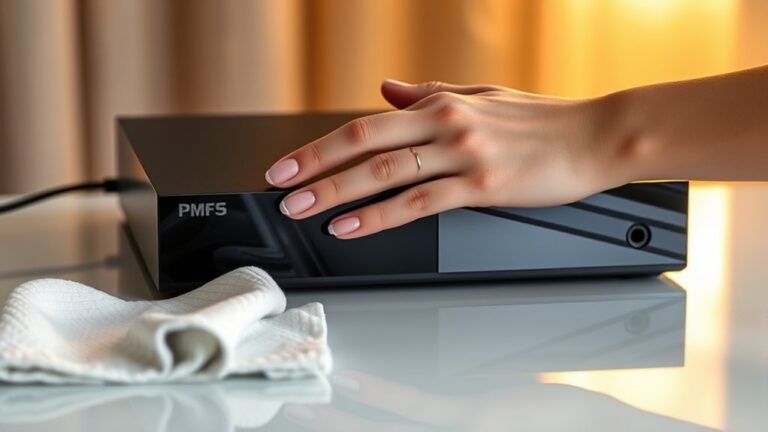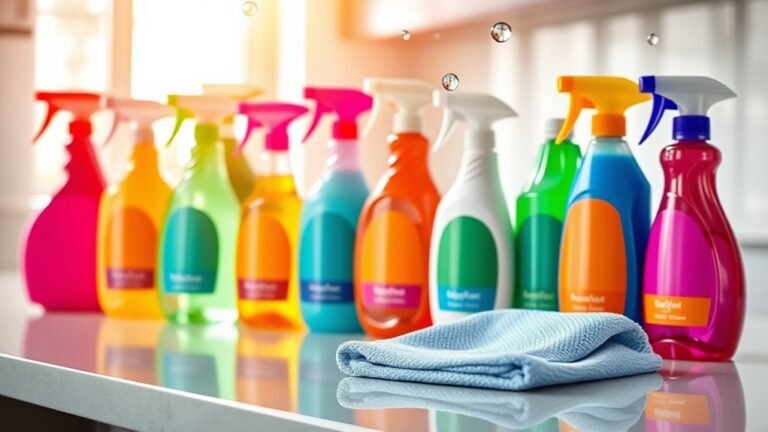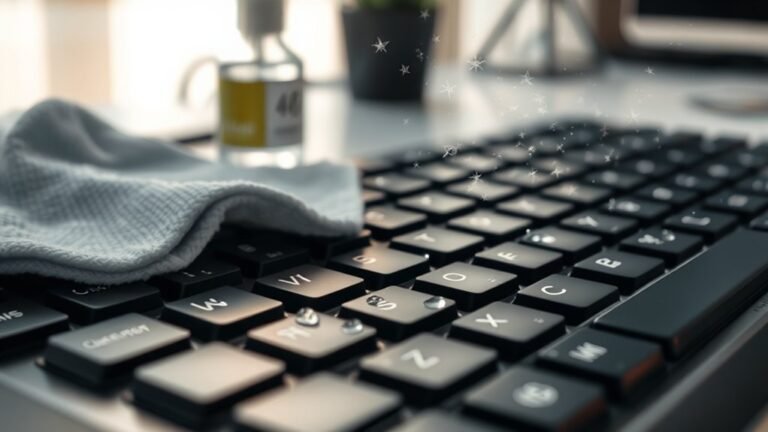How to Make Homemade Printer Cleaner
You can make a simple, effective printer cleaner by mixing equal parts distilled water and isopropyl alcohol with a few drops of mild dish soap. Use a microfiber cloth or cotton swabs to gently clean print heads and cartridges, being careful not to soak parts. Remember to power off your printer first and handle components delicately. Keeping your printer clean improves performance and print quality. Keep exploring to find out how to maintain your printer safely and troubleshoot common issues.
Understanding Printer Cleaning Needs
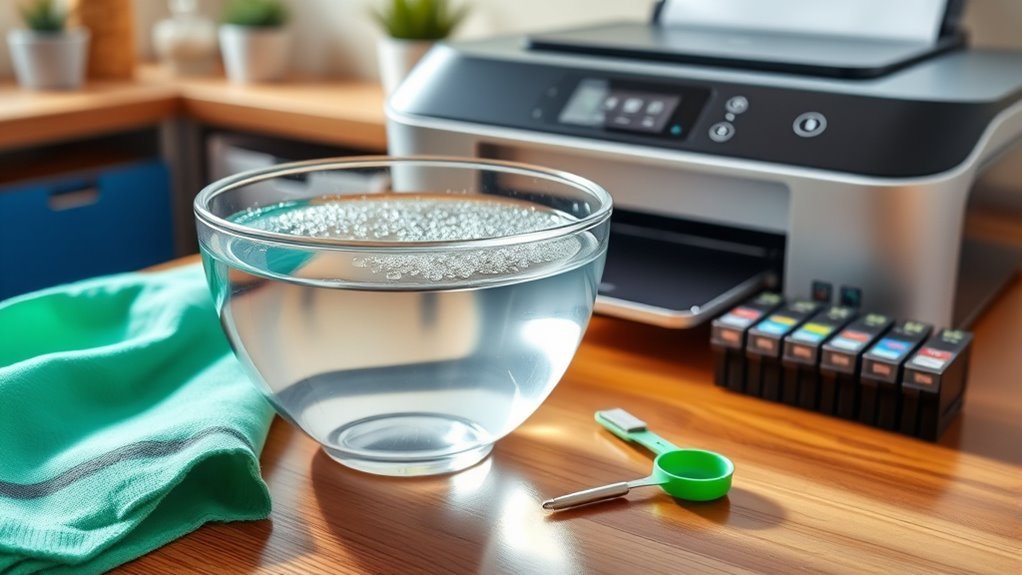
To keep your printer running smoothly, it’s important to understand why and when it needs cleaning. Regular printer maintenance prevents clogs, smudges, and paper jams that can disrupt your freedom to print whenever you want. You don’t want to be stuck waiting on a repair or buying expensive replacements. The cleaning frequency depends on your printer’s usage—if you print daily, cleaning every month works; for occasional use, every few months suffices. Dust, ink residue, and debris accumulate inside, degrading print quality and causing errors. By recognizing these signs early and sticking to a consistent cleaning schedule, you maintain control over your device’s performance. This way, your printer stays reliable, letting you print freely without interruptions or frustration.
Essential Ingredients for Homemade Printer Cleaner
Creating an effective homemade printer cleaner starts with choosing the right ingredients. You’ll want components that support your printer maintenance routine without causing damage. Keeping your cleaning frequency balanced guarantees your printer stays in top shape without overdoing it. Here’s a quick guide to essential ingredients you’ll need:
| Ingredient | Purpose |
|---|---|
| Isopropyl Alcohol | Dissolves ink and grime |
| Distilled Water | Prevents mineral buildup |
| Mild Dish Soap | Cuts grease and dirt |
These simple ingredients give you freedom from expensive commercial cleaners while maintaining your printer’s health. Remember, use the cleaner sparingly and adjust your cleaning frequency based on how often you print to avoid wear and tear.
Tools Required for Cleaning Your Printer

Before you start cleaning, you’ll need a few essential tools like microfiber cloths, cotton swabs, and a soft brush to reach tight spots. Don’t forget safety gear such as gloves and eye protection to keep yourself safe from any cleaning solution splashes. Having the right equipment will make the process smoother and protect both you and your printer.
Essential Cleaning Tools
A few essential tools can make cleaning your printer much easier and more effective. To maintain freedom from costly repairs, you’ll want tools made from quality materials—like microfiber cloths that won’t scratch surfaces and soft-bristle brushes for delicate parts. Having a small vacuum with a gentle nozzle helps remove dust without damage. Keep cotton swabs handy for tight spots, but choose ones with sturdy stems to avoid breakage. Your cleaning frequency depends on how often you print, but regular upkeep prevents buildup that compromises performance. Avoid harsh materials that can harm your printer’s internal components. By selecting the right tools, you empower yourself to care for your printer confidently, extending its life without relying on expensive services or replacements.
Safety Equipment Needed
Three essential safety items you’ll want when cleaning your printer include gloves, safety glasses, and a dust mask. These protect you from ink stains, chemical exposure, and dust particles that can irritate your skin and lungs. To keep your cleaning experience safe and hassle-free, make sure you have:
- Disposable gloves – They shield your hands from ink and cleaning solutions, letting you work freely without worry.
- Safety goggles – Protect your eyes from splashes and airborne particles, so you can focus on the job without distractions.
- Dust mask – Prevent inhaling any fine dust or fumes, giving you the freedom to clean thoroughly without compromising your health.
With these safety tools in place, you’re all set to clean your printer confidently and effectively.
Step-by-Step Guide to Making Printer Cleaner Solution
You’ll need just a few basic ingredients to make an effective printer cleaner solution. I’ll walk you through the simple mixing steps to guarantee it’s safe and efficient. Plus, I’ll share tips on how to store your solution and use it properly for the best results.
Essential Ingredients Needed
Before you start mixing your printer cleaner solution, it’s important to gather all the essential ingredients to guarantee effectiveness and safety. Proper printer maintenance relies on using the right components, especially if you want to maintain an ideal cleaning frequency without damaging your device. Here are the three key ingredients you’ll need:
- Distilled water – avoids mineral deposits and guarantees a pure base for cleaning.
- Isopropyl alcohol (at least 90%) – effectively dissolves ink residue and dries quickly.
- A mild, non-abrasive dish soap – helps break down stubborn grime without harming printer parts.
Having these on hand gives you control over your printer upkeep, letting you clean confidently and freely on your schedule.
Mixing Instructions Explained
Although it might seem straightforward, mixing your printer cleaner solution carefully guarantees it works effectively without damaging your device. Start by measuring your ingredients precisely, sticking to recommended mixing ratios—usually one part isopropyl alcohol to two parts distilled water. This balance assures the solution consistency is just right: fluid enough to penetrate ink clogs but gentle enough to avoid harming printer components. Pour your ingredients into a clean container and stir gently until fully combined. Avoid shaking vigorously, as this can cause unwanted bubbles or uneven mixing. Remember, maintaining the right mixing ratios and solution consistency gives you control, allowing you to create a powerful cleaner while preserving your printer’s freedom to function smoothly. Simple, precise mixing is key to reliable, homemade printer cleaner success.
Storage and Usage Tips
Once your printer cleaner solution is mixed just right, knowing how to store and use it properly will keep it effective and safe. To maximize freedom and convenience, follow these tips:
- Use airtight storage containers to prevent evaporation and contamination. Glass or high-quality plastic bottles work best.
- Always apply proper labeling to your containers. Include the date mixed and ingredients to avoid confusion and guarantee safe handling.
- When using the cleaner, apply it sparingly with a cotton swab or cloth to targeted areas. Avoid overuse, which can damage printer components.
How to Safely Clean Printer Cartridges
To safely clean your printer cartridges, you’ll need just a few simple tools and a gentle touch. Different printer cartridge types may require slightly different care, but the main goal is to avoid damage while addressing ink clogging causes, like dried ink or dust buildup. Always handle cartridges with clean hands and avoid harsh chemicals.
| Step | Tool Needed | Tip |
|---|---|---|
| Remove cartridge | Glove | Power off printer first |
| Inspect nozzles | Magnifying glass | Check for dried ink |
| Clean edges | Lint-free cloth | Use distilled water only |
| Avoid soaking | N/A | Soaking can damage cartridges |
| Reinstall carefully | N/A | Align properly to prevent leaks |
Following these steps keeps your cartridges free and your printing, flawless.
Cleaning Printer Heads With Homemade Solution
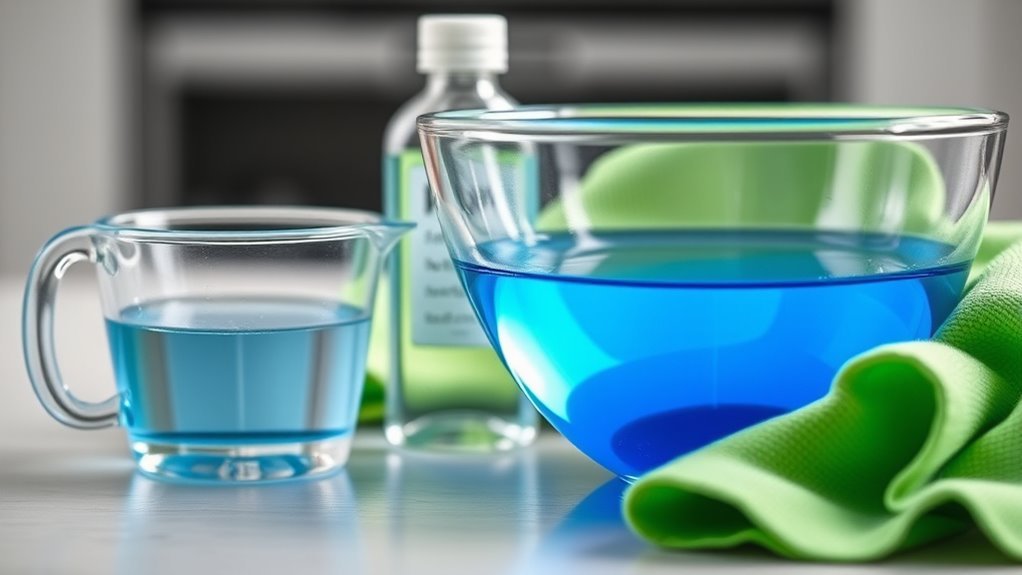
If you notice streaks or faded colors in your prints, cleaning the printer heads with a homemade solution can be an effective and affordable fix. This helps keep your printer ink flowing smoothly without costly replacements. To do it right, follow these steps:
- Mix equal parts distilled water and isopropyl alcohol to create your cleaning solution.
- Dip a lint-free cloth or cotton swab into the mixture, then gently wipe the printer heads.
- Allow the heads to dry completely before reinstalling cartridges and printing.
Tips for Maintaining Printer Performance
Although regular cleaning is crucial, there are other simple steps you can take to keep your printer running smoothly. Stick to a consistent maintenance schedule to prevent issues before they start. Regularly check ink or toner levels and replace cartridges promptly to maintain ideal print quality. Use high-quality paper to avoid jams and reduce wear on internal parts. Keep your printer in a dust-free environment and cover it when not in use to protect sensitive components. Also, update your printer’s software and drivers to guarantee compatibility and peak performance. By following these straightforward tips, you’ll enjoy freedom from frustrating printer problems and consistently crisp, clear prints without unnecessary downtime. Your printer will thank you for the care.
Troubleshooting Common Printer Cleaning Issues
Keeping up with regular printer maintenance can prevent many problems, but you might still run into some cleaning-related issues. Don’t worry—here’s how to troubleshoot common ones:
Regular printer upkeep helps avoid issues, but cleaning problems can still arise—here’s how to troubleshoot them effectively.
- Printer streaks: These often happen if the cleaning solution is too harsh or applied unevenly. Use a gentle homemade cleaner and a soft cloth to wipe the print heads carefully.
- Ink smudges: If prints come out smudged, it might mean the ink isn’t drying properly. Make sure you’re not over-cleaning the rollers, which can cause excess moisture.
- Clogged nozzles: If cleaning doesn’t fix faded prints, try running the printer’s built-in nozzle cleaning cycle before applying homemade solutions.
Frequently Asked Questions
Can Homemade Cleaner Damage My Printer Warranty?
Using homemade cleaner on your printer is like walking a tightrope—one wrong step could void your printer warranty. While you might crave freedom from pricey solutions, cleaner risks are real; some homemade mixtures can damage delicate parts or leave residues. If your printer’s still under warranty, it’s safer to stick with approved products. You want freedom, but don’t let cleaner risks clip your printer’s protection wings.
How Often Should I Clean My Printer Cartridges?
You should stick to a regular printer maintenance schedule to keep your cartridges in top shape. Cleaning frequency really depends on how often you print, but generally, every 3 to 6 months works well. If you notice streaks or fading, it’s a sign you need to clean sooner. By staying consistent, you’ll avoid clogs and enjoy freedom from annoying print jams or poor-quality prints. Keep things smooth and hassle-free!
Is It Safe to Use Homemade Cleaner on All Printer Brands?
You should be cautious with homemade cleaning solutions since printer compatibility varies among brands. Not all printers react well to DIY cleaners, and using the wrong one could damage delicate parts. It’s best to check your printer’s manual or manufacturer guidelines before trying any homemade cleaner. This way, you maintain your freedom to clean responsibly without risking costly repairs or voiding warranties due to incompatible cleaning solutions.
Can I Use This Cleaner for Inkjet and Laser Printers?
Imagine your printer as a delicate dance partner—each step precise and graceful. When it comes to inkjet compatibility, your homemade cleaner can gently glide across the delicate nozzles without missing a beat. But laser compatibility is trickier; the toner and drum need special care, so homemade solutions might not always play nice. You want freedom, but sometimes it’s best to choose cleaners designed specifically for each printer type to keep the rhythm smooth.
How Do I Store Leftover Homemade Printer Cleaner Safely?
To store your leftover homemade printer cleaner safely, use airtight storage containers to maintain cleaner longevity and prevent spills. Glass jars with tight lids work great, keeping the mixture fresh and effective. Keep the container in a cool, dark place away from direct sunlight and extreme temperatures. This way, you’ll enjoy maximum freedom to reuse your cleaner without worrying about it losing potency or causing any mess.



